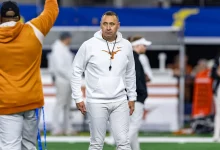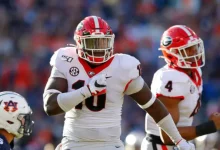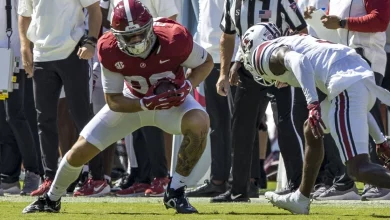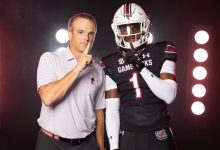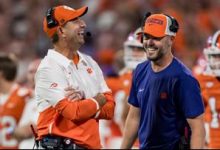Caleb Williams explains why he and his dad schemed to avoid going to the Bears from USC

When a talented young quarterback like Caleb Williams transitions from college football to the NFL, the decision-making process around which team to join is often complex and filled with emotions, strategy, and family input. Williams, who made headlines both at USC and now as a Chicago Bears quarterback, recently opened up about a surprising chapter in his journey — a plan he and his father hatched to avoid joining the Bears initially.
This revelation sheds light not only on Caleb’s mindset but also on the often-overlooked role family plays in shaping an athlete’s career decisions. In this article, we explore the reasons behind this scheme, what it meant for Williams’ development, and how it ultimately influenced his path to the NFL.
The Context: Caleb Williams’ Rise at USC
Caleb Williams’ college career was marked by rapid ascension and intense attention. Transferring from Oklahoma to USC, he quickly became the centerpiece of the Trojans’ offense and one of the nation’s most electrifying quarterbacks. His combination of arm strength, athleticism, and poise made him a top prospect for the NFL Draft.
As draft day approached, the decision of where Williams would land became a hot topic. The Chicago Bears, holding a key position in the draft order, emerged as a potential landing spot. However, Williams’ recent comments reveal that he and his father were initially keen on avoiding that scenario.
Why the Hesitation? Concerns About the Bears
Caleb Williams and his father’s scheme to avoid the Bears was rooted in several concerns:
1. Team Performance and Stability
At the time of their planning, the Bears were in a phase of rebuilding. The team had struggled with inconsistent performances and lacked a clear offensive identity. Williams and his family questioned whether the organization could provide the right environment for a young quarterback to thrive immediately.
2. Coaching and Development
Quarterback development depends heavily on coaching staff expertise and consistency. Williams and his father were reportedly unsure about the Bears’ ability to develop a young QB properly, given recent coaching changes and offensive struggles.
3. Fit with Offensive Scheme
Williams’ skill set as a dynamic, mobile quarterback required an offense that would maximize his strengths. There was concern that the Bears’ current offensive scheme might not be the best fit, potentially limiting his ability to succeed early in his career.
4. Geographic and Lifestyle Preferences
Moving to a new city comes with adjustments off the field. Williams and his family considered lifestyle and comfort, which factored into their initial hesitation about Chicago.
The Family’s Role: A Strategic Partnership
Caleb’s father played a critical role in navigating the complexities of the draft process. Their “scheme” involved exploring other options, leveraging conversations with agents, and considering alternative scenarios that might keep Williams away from Chicago.
This partnership exemplifies how family support often goes beyond emotional encouragement to active involvement in career strategy. For Caleb, having a trusted advisor in his father provided a sounding board for decisions and helped balance excitement with practical concerns.
How the Plan Unfolded
The exact details of the “scheme” haven’t been fully disclosed, but Williams described it as a combination of:
- Exploring Other Teams: Engaging in discussions and interviews to gauge interest and fit elsewhere.
- Leveraging Agent Advice: Collaborating with his agent to understand the draft dynamics and team needs.
- Preparing Mentally: Focusing on staying flexible and ready for any outcome, including the possibility of landing with the Bears despite their plan.
Ultimately, this strategic thinking allowed Williams to enter the draft process with a clear perspective and control over his options.
What Changed? Why Did Williams End Up with the Bears?
Despite their initial plans, Williams was eventually drafted by the Chicago Bears, a decision that surprised some but made sense in hindsight.
1. Organizational Changes
The Bears underwent shifts in coaching staff and front-office leadership that improved the team’s outlook. New hires focused on quarterback development and offense hinted at a better fit for Williams’ talents.
2. Williams’ Own Growth
As draft evaluations progressed, Williams grew more confident in his ability to adapt and succeed regardless of the team. His focus shifted from avoidance to embracing opportunity.
3. The Bears’ Commitment
The Bears demonstrated a commitment to building around Williams, offering assurances about the offensive scheme and future plans. This helped alleviate earlier concerns.
4. Acceptance of the Challenge
Williams recognized that challenges are part of any NFL career and that Chicago presented a platform to prove himself and make an impact.
The Bigger Picture: Lessons in Athlete Decision-Making
Caleb Williams’ story highlights key lessons about the draft process and athlete career decisions:
- Family Influence Matters: Family members often serve as key advisors and protectors in an athlete’s journey.
- Strategic Planning Is Crucial: Athletes must weigh multiple factors beyond raw talent, including team culture, coaching, and personal fit.
- Flexibility Is Key: Even with plans in place, adaptability can lead to unexpected but rewarding outcomes.
- Embracing Uncertainty: The NFL draft is unpredictable, and success often comes from making the best of any situation.
Reflections From Caleb Williams
In interviews, Williams has spoken candidly about this phase, emphasizing:
- The importance of trust between him and his father.
- How the experience taught him patience and perspective.
- His commitment to giving his all with the Bears, regardless of initial hesitations.
- Gratitude for the support system that guided him through the process.
How This Experience Shapes Williams’ Future
The lessons learned from scheming to avoid the Bears and ultimately embracing the opportunity have strengthened Williams mentally and emotionally.
- Resilience: Facing and overcoming doubts prepares him for the ups and downs of an NFL career.
- Leadership: His thoughtful approach to decisions translates to leadership on the field.
- Focus: Williams’ clarity on his goals helps him stay driven amid distractions.
- Gratitude: Appreciation for the journey fuels his motivation to succeed.
Caleb Williams’ candid explanation about trying to avoid joining the Bears reveals much about the complexities behind NFL draft decisions. It also offers a window into the powerful role family plays in guiding young athletes through life-changing moments.
While the Bears may not have been the preferred destination initially, Williams’ willingness to embrace the challenge underscores his maturity and determination. As he embarks on his professional career, that mindset — forged through careful planning and honest reflection — will be a key asset.
Ultimately, this story isn’t just about a player and a team; it’s about growth, trust, and the unpredictable path to success in the NFL.

